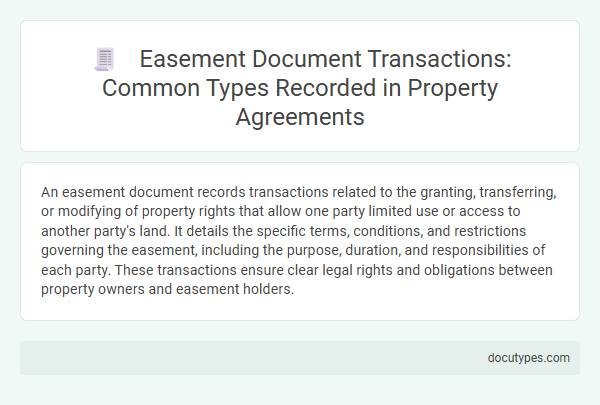An easement document records transactions related to the granting, transferring, or modifying of property rights that allow one party limited use or access to another party's land. It details the specific terms, conditions, and restrictions governing the easement, including the purpose, duration, and responsibilities of each party. These transactions ensure clear legal rights and obligations between property owners and easement holders.
Understanding Easement Documents in Property Agreements
Easement documents in property agreements record specific types of transactions that grant usage rights over a portion of land. Understanding these transactions helps you recognize legal boundaries and responsibilities associated with the property.
- Grant of Easement - Details the permission given by the property owner to another party to use or access their land for a defined purpose.
- Scope of Use - Specifies the nature and limitations of the easement, including what activities are allowed and any restrictions.
- Duration and Termination - Outlines the time frame for which the easement is valid and conditions under which it may end or be revoked.
These components ensure clear understanding and legal clarity in property easement agreements.
Importance of Easement Transactions in Real Estate
Easement documents record transactions that grant, modify, or terminate the rights to use a portion of property without transferring ownership. These transactions often involve rights of way, utility access, and shared driveways, essential for various property functions.
Recording easement transactions is crucial in real estate because it ensures clear and legal documentation of usage rights, which protects property values and prevents disputes. Properly documented easements help buyers, sellers, and lenders understand existing property limitations and obligations. This transparency supports smooth real estate transactions and long-term property management.
Common Types of Easements Documented in Property Records
Easement documents record specific property rights allowing limited use by one party over another's land. Understanding common easement types helps you identify the rights and restrictions tied to your property.
- Right of Way - Grants access across a property for roads, driveways, or pathways.
- Utility Easement - Allows utility companies to install and maintain infrastructure like power lines and pipelines.
- Drainage Easement - Permits water flow management through another property to prevent flooding or erosion.
Right-of-Way Easements: Definition and Usage
| Transaction Type | Description |
|---|---|
| Grant of Easement | Legal agreement granting right-of-way access across a property for specific purposes such as utilities, roads, or pedestrian pathways. Defines the parties involved, easement boundaries, and duration. |
| Transfer of Easement Rights | Recording of the sale, assignment, or transfer of easement rights from one party to another, ensuring the new easement holder has documented legal access. |
| Modification of Easement Terms | Updates or changes to the original easement agreement, including alterations to route, scope, or usage restrictions. Modifications require legal documentation and recording. |
| Termination or Release of Easement | Official relinquishment or cancellation of easement rights, often recorded when the right-of-way is no longer needed or has been superseded by other arrangements. |
| Rights and Responsibilities | Details on maintenance obligations, usage limitations, and access rights related to the right-of-way easement to prevent disputes between property owners and easement holders. |
Utility Easements: Ensuring Access and Maintenance
Utility easements grant specific rights to utility companies, allowing them to access private property for installation, maintenance, and repair of essential services like water, electricity, and telecommunications. These transactions are formally recorded to ensure legal clarity and protect both property owners and utility providers.
Recorded details typically include the location, dimensions, and purpose of the easement, along with the parties involved and any restrictions on use. This documentation guarantees uninterrupted utility service access while preserving property rights, preventing disputes over maintenance responsibilities.
Access Easements: Shared Driveways and Walkways
An easement document records transactions granting legal rights to use a portion of property for specific purposes. Access easements commonly include shared driveways and walkways, allowing multiple property owners to cross or use designated areas. These transactions ensure clear boundaries, usage terms, and responsibilities for maintenance between involved parties.
Drainage and Sewer Easements: Property Implications
Drainage and sewer easements document the legal rights allowing the installation and maintenance of drainage or sewer lines across a property. These transactions specify the scope of access for utility providers to prevent obstruction or damage to essential infrastructure. Property owners must acknowledge these easements as they can affect land use, development potential, and future property value.
Conservation Easements: Environmental Protections
Easement documents record specific transactions that grant or restrict property rights, including rights of access, use limitations, and maintenance responsibilities. Conservation easements focus on preserving environmental values by limiting development and protecting natural resources on the land.
These transactions detail the obligations for land stewardship and environmentally sensitive practices that safeguard habitats, water quality, and scenic landscapes. Your conservation easement ensures that these environmental protections remain legally enforceable for current and future property owners.
Recording Easement Agreements: Legal Requirements
Easement documents record specific property rights allowing use or access to another's land. Recording easement agreements ensures legal recognition and public notice of these rights.
- Type of Easements Recorded - Easement documents commonly record access, utility, or conservation easements affecting property use.
- Legal Description Requirement - Accurate legal descriptions of the servient and dominant estates must be included to validate the easement.
- Your Role in Recording - You must submit the easement agreement to the appropriate county recorder's office to satisfy state recording statutes.
What Types of Transactions Are Recorded in an Easement Document? Infographic

